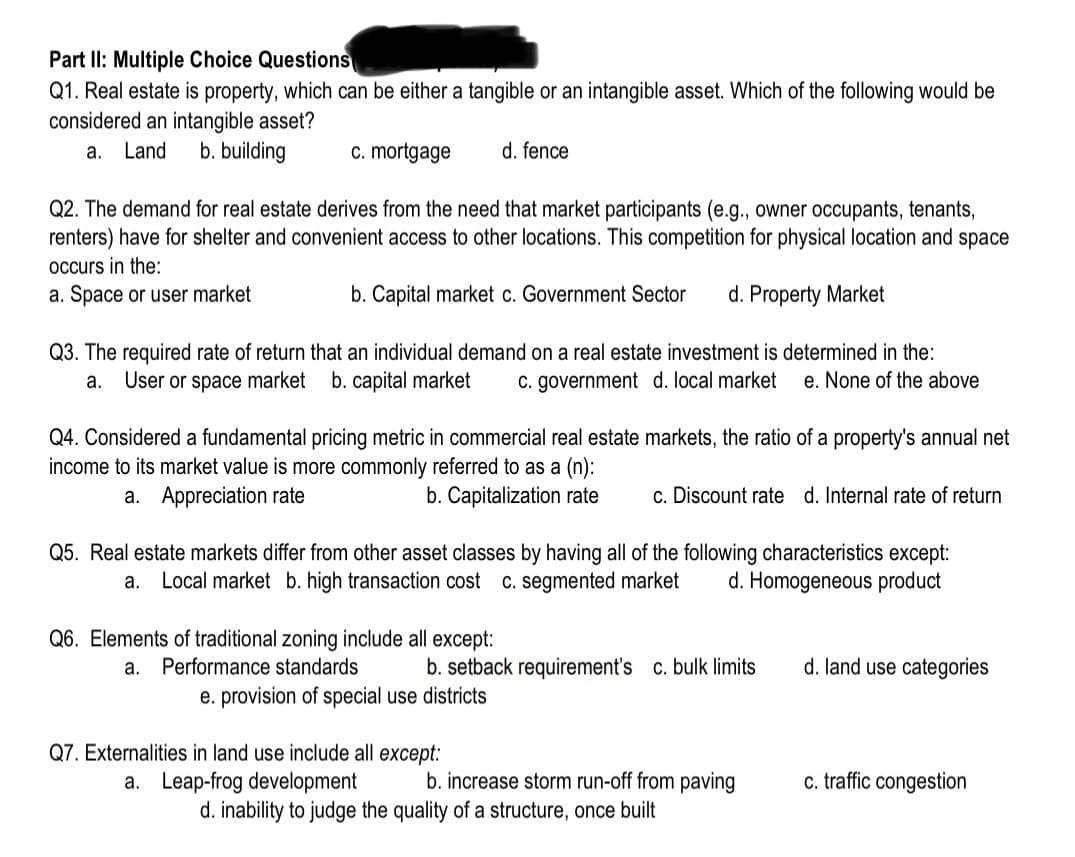Q1. Real estate is property, which can be either a tangible or an intangible asset. Which of the following would be considered an intangible asset? a. Land b. building c. mortgage d. fence
Q1. Real estate is property, which can be either a tangible or an intangible asset. Which of the following would be considered an intangible asset? a. Land b. building c. mortgage d. fence
Economics: Private and Public Choice (MindTap Course List)
16th Edition
ISBN:9781305506725
Author:James D. Gwartney, Richard L. Stroup, Russell S. Sobel, David A. Macpherson
Publisher:James D. Gwartney, Richard L. Stroup, Russell S. Sobel, David A. Macpherson
Chapter27: Investment, The Capital Market, And The Wealth Of Nations
Section: Chapter Questions
Problem 5CQ
Related questions
Question
Answer all questions

Transcribed Image Text:Part II: Multiple Choice Questions
Q1. Real estate is property, which can be either a tangible or an intangible asset. Which of the following would be
considered an intangible asset?
a. Land b. building
c. mortgage
Q2. The demand for real estate derives from the need that market participants (e.g., owner occupants, tenants,
renters) have for shelter and convenient access to other locations. This competition for physical location and space
occurs in the:
a. Space or user market
b. Capital market c. Government Sector d. Property Market
Q3. The required rate of return that an individual demand on a real estate investment is determined in the:
User or space market b. capital market c. government d. local market e. None of the above
a.
Q4. Considered a fundamental pricing metric in commercial real estate markets, the ratio of a property's annual net
income to its market value is more commonly referred to as a (n):
a. Appreciation rate
b. Capitalization rate
d. fence
Q6. Elements of traditional zoning include all except:
a. Performance standards
Q5. Real estate markets differ from other asset classes by having all of the following characteristics except:
a. Local market b. high transaction cost c. segmented market d. Homogeneous product
e. provision of special use districts
c. Discount rate d. Internal rate of return
b. setback requirement's c. bulk limits
Q7. Externalities in land use include all except:
a. Leap-frog development
b. increase storm run-off from paving
d. inability to judge the quality of a structure, once built
d. land use categories
c. traffic congestion
Expert Solution
This question has been solved!
Explore an expertly crafted, step-by-step solution for a thorough understanding of key concepts.
Step by step
Solved in 4 steps

Knowledge Booster
Learn more about
Need a deep-dive on the concept behind this application? Look no further. Learn more about this topic, economics and related others by exploring similar questions and additional content below.Recommended textbooks for you

Economics: Private and Public Choice (MindTap Cou…
Economics
ISBN:
9781305506725
Author:
James D. Gwartney, Richard L. Stroup, Russell S. Sobel, David A. Macpherson
Publisher:
Cengage Learning

Microeconomics: Private and Public Choice (MindTa…
Economics
ISBN:
9781305506893
Author:
James D. Gwartney, Richard L. Stroup, Russell S. Sobel, David A. Macpherson
Publisher:
Cengage Learning

Managerial Economics: A Problem Solving Approach
Economics
ISBN:
9781337106665
Author:
Luke M. Froeb, Brian T. McCann, Michael R. Ward, Mike Shor
Publisher:
Cengage Learning

Economics: Private and Public Choice (MindTap Cou…
Economics
ISBN:
9781305506725
Author:
James D. Gwartney, Richard L. Stroup, Russell S. Sobel, David A. Macpherson
Publisher:
Cengage Learning

Microeconomics: Private and Public Choice (MindTa…
Economics
ISBN:
9781305506893
Author:
James D. Gwartney, Richard L. Stroup, Russell S. Sobel, David A. Macpherson
Publisher:
Cengage Learning

Managerial Economics: A Problem Solving Approach
Economics
ISBN:
9781337106665
Author:
Luke M. Froeb, Brian T. McCann, Michael R. Ward, Mike Shor
Publisher:
Cengage Learning

Brief Principles of Macroeconomics (MindTap Cours…
Economics
ISBN:
9781337091985
Author:
N. Gregory Mankiw
Publisher:
Cengage Learning